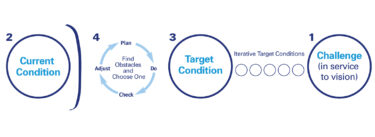“How do I get business results from a lean program?” I often hear this question from senior leaders. Understandably, executives tend to see the world in terms of business issues, which they try to solve with business best practices. Lean guys, on the other hand, see “lean” problems, which they then address with lean tools. These conflicting objectives result in total confusion as middle managers complain that they understand the intent and purpose of solving problems with teams at the gemba, but all they’re asked for from above is better numbers.
The challenge of any lean transformation is to address business issues with lean tools and principles in order to teach people to find leaner countermeasures—but that’s easier said than done. From experience, this goal requires four difficult steps:
- First, grow a culture of problem-solving, where it’s OK to address problems without immediately triggering conflict, emotional reactions, and the usual food fights and blame games.
- Second, convince executives to look at business problems, say lack of growth or profitability, as physical problems. As Orry Fiume taught me long ago, every line in a budget corresponds to a physical quantity multiplied by a price or a cost—which means that a budget line must be understood in terms of the underlying physical quantities being produced, moved, shipped, consumed, or wasted.
- Third, teach executives to check their problem-understanding with real people and real facts on the gemba to make sure they correctly understand what is truly causing the problems—and this is hard because it involves not only getting out of the office to the real place where things are happening, but learning to talk to people in a way that they actually tell you what is going on, rather than hide it and wait for you to go away.
- Fourth, show executives how to encourage immediate countermeasures and then build more long-term solutions with the people who do the work (and whose ownership is needed to make any concrete solution stick). And, from then on, establish a constant dialogue on where there is progress and where we keep repeating the same mistakes again and again, to progressively root out misconceptions about how business is done around here.
Quite a tall order, when you come to think about it. When leaders succeed in these four steps, results are spectacular, but, not surprisingly, many fail simply because they don’t understand the progression of getting closer to the gemba with business aims in mind. Standardizing processes won’t cut it if you don’t develop people with standardized skills as well, such as solving problems, encouraging kaizen, managing conflict, communicating and motivating teams, and so on.
The magic trick of the leaders who succeed at lean transformation? They understand the power of visualization. Most problems occur at interfaces—either between specialties or between management levels. To address these problems, we can think back to antiquity and Plato’s academy: visualize a peaceful grove on the outskirts of ancient Athens where thinkers would gather to discuss intractable problems of metaphysics, mathematics, ethics, cosmology, and so on. In more modern terms, we create obeyas where problem A3s are posted so they can be discussed and so leaders can see:
- What problems are being recognized and addressed (and what are not)?
- How do people go about solving these problems (and how they do not)?
- How involved are gemba people in solving the problems (or are they even being consulted)?
- How is the follow-up on countermeasures (is there reflection, review, revisit, or not)?
Managers serious in making problems visible in their areas will soon understand and adopt other visual tools of lean, such as:
- The defects garden patch in which to record and visualize how many and what defects are being produced,
- Kanbans to visualize how smoothly workflows (or where it gets stuck with inventory and backlog),
- Andon to get closer to problems where and when the tool touches parts wrong, and see whether the managerial line reacts as a chain of support or a chain of command, and
- Parts analysis boards to see how teams monitor their performance and track their issues.
Making problems visible on the shop floor at the team level with the usual lean tools and making problem-solving visible throughout the company are keys to creating the culture of problem-solving we seek, orienting it toward business issues. True problem-solving will be visualized differently at different levels in the hierarchy. Teams’ work is mostly about habits and how these work out—or no—according to context, so simple problem boards will suffice. Management is mostly about maintaining and changing processes, so quality control stories will do the trick. Executive level is about making the right decisions collaboratively, so full A3 problem-solving is often required.
Why magic? Because these various formats create a discussion space where top leaders can meet with coal-face teams and discuss problems nonconfrontationally. Team members can expose their difficulties. Leaders can look for value and how it impacts the business. Managers can see what needs to be maintained and what needs to be changed.
Standard formats for problem-solving at various levels create standardized interfaces that allows people to focus away from each other (a face-to-face conversation between the CEO and a line worker is often awkward because of the huge power gradient and difference in perspective) and focus together on the problem that needs solving. When CEOs grasp that trick and start using it systematically, it changes their business. When CEOs start promoting executives that share this understanding, it transforms the business.
To achieve business results with lean efforts, we need to be looking for value, recognize non-value, and figure out the common misconceptions at the root of producing non-value day to day (someone gave the order, someone had that habit, and so on) in a collaborative, least confrontational way possible (understanding some people will fight for their misconceptions). Doing so starts with a clear grasp of the power of visualization.





